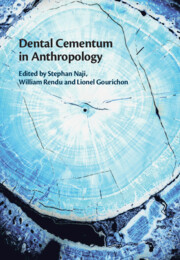Book contents
- Dental Cementum in Anthropology
- Dental Cementum in Anthropology
- Copyright page
- Dedication
- Contents
- Contributors
- Foreword
- Introduction: Cementochronology in Chronobiology
- Part I The Biology of Cementum
- Part II Protocols
- Part III Applications
- 17 Using Cementochronology to Discuss the Organization of Past Neanderthal Societies
- 18 Investigating Seasonal Competition between Hominins and Cave Hyaenas in the Belgian Ardennes during the Late Pleistocene: Insights from Cementum Analyses
- 19 Cementochronology to the Rescue: Osteobiography of a Middle Woodland Woman with a Combined Skeletal Dysplasia
- 20 Estimating a Mortality Profile of Fisher-Gatherers in Brazil Using Cementochronology
- 21 Cementochronology: A Solution to Reconstructing Past Populations’ Mortality Profiles Using Individual Age-at-Death Estimates
- 22 Assessing Age-Related Mortality at Petra, Jordan, Using Cementochronology and Hazard Modeling
- 23 Shaping Age-at-Death Distributions by Applying Tooth Cementum Analysis to the Early Medieval Graveyard of Lauchheim (Germany)
- 24 Back to the Root: The Coming of Age of Cementochronology
- Index
- Plate Section (PDF Only)
- References
20 - Estimating a Mortality Profile of Fisher-Gatherers in Brazil Using Cementochronology
from Part III - Applications
Published online by Cambridge University Press: 20 January 2022
- Dental Cementum in Anthropology
- Dental Cementum in Anthropology
- Copyright page
- Dedication
- Contents
- Contributors
- Foreword
- Introduction: Cementochronology in Chronobiology
- Part I The Biology of Cementum
- Part II Protocols
- Part III Applications
- 17 Using Cementochronology to Discuss the Organization of Past Neanderthal Societies
- 18 Investigating Seasonal Competition between Hominins and Cave Hyaenas in the Belgian Ardennes during the Late Pleistocene: Insights from Cementum Analyses
- 19 Cementochronology to the Rescue: Osteobiography of a Middle Woodland Woman with a Combined Skeletal Dysplasia
- 20 Estimating a Mortality Profile of Fisher-Gatherers in Brazil Using Cementochronology
- 21 Cementochronology: A Solution to Reconstructing Past Populations’ Mortality Profiles Using Individual Age-at-Death Estimates
- 22 Assessing Age-Related Mortality at Petra, Jordan, Using Cementochronology and Hazard Modeling
- 23 Shaping Age-at-Death Distributions by Applying Tooth Cementum Analysis to the Early Medieval Graveyard of Lauchheim (Germany)
- 24 Back to the Root: The Coming of Age of Cementochronology
- Index
- Plate Section (PDF Only)
- References
Summary
The evolution of nomadic collectors' fertility and mortality before the agriculture invention in independent centers 10,000 years ago is still debated. Skeletal samples are the only way to observe prehistoric demographic patterns directly. Each assemblage is critical for direct investigation since pre-farming groups exhibit high residential mobility. Cabeçuda is a funerary mound (sambaqui) in Santa Catarina State, Brazil. Its occupation (4,180BP-1,800BP) corresponds to its expansion peak and decline with horticulturalists' arrival. A cementochronology analysis of 93 skeletons suggests a high frequency of young adults and a lack of adults past 60, which departs from contemporary collector models but is common in catastrophic samples or migratory events. The metabolic load model predicts that a group of semi-nomadic fisher-gatherers should display transitional fertility between sedentary farmers and nomadic collectors. This is the case for Cabeçuda with a 15P5 ratio below and a TFR within all contemporary pre-farming groups. However, within a quasi-stable hypothesis, several variables can produce the same output, and we lack the data to evaluate the death structure.
- Type
- Chapter
- Information
- Dental Cementum in Anthropology , pp. 322 - 337Publisher: Cambridge University PressPrint publication year: 2022



